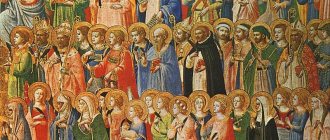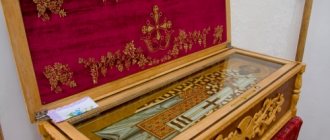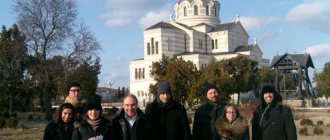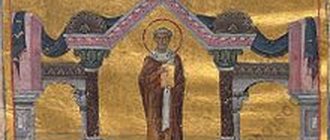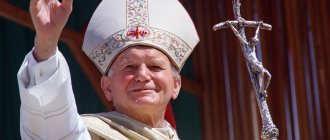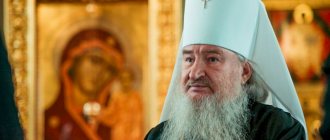Clement V
Clement V
(June 5, 1305 - April 20, 1314) - Pope, successor of Benedict XI, before the papacy called Bertrand de Gault, Gascon by birth, belonged to the famous family of Périgord and Armagnac. Born in 1264, he was educated in Toulouse, and then in Orleans and Bologna. He made a relatively quick career, starting it as a canon in Bordeaux; then he was vicar general in Lyon, archbishop in the same city, papal chaplain and, finally, archbishop of Bordeaux. At the conclave in Perugio, Bertrand was elected pope by ten votes out of 15, not without pressure from Philip the Fair, who considered him the most suitable candidate for the papal throne, hoping to maintain and even strengthen French influence on the papacy. And the king was not mistaken in his calculations; the new pope, who took the name Clement V (July 23, 1305), was a kind and noble man by nature, but these qualities turned into weakness in him. If the policy of his predecessor Benedict XI was distinguished by excessive compliance in relation to Philip the Fair, then with Clement V it acquired the character of direct connivance and even servility. Not hoping to establish himself in Italy and restore order and tranquility there, the new pope first led a wandering life, stopping at more or less long time in different cities - Cluny, Nevers, Bourges, Bordeaux, Poitiers, etc., until he established himself in Avignon - a city that belonged to the Count of Provence, but at the same time was included in the County of Venessen, the property of the Holy See Clement V arrived in Avignon in the spring of 1309 and, having settled there, found himself completely in the power of the French king. This began one of the saddest periods in the history of the papacy (“Babylonian captivity”) - a period of deep decline of the papacy and the authority of the church, the era of their humiliating position both morally and politically, preparing the way for the reformation.Taking advantage of the fact that Clement V in Avignon was in complete political dependence on the French king, Philip the Fair forced the weak-willed pope to renounce many of the privileges of the Roman throne in relation to France. Thus, Clement V recognized the repeal of the bull Clericis laicos in all that it introduced something new into church law, and issued a declaration that the bull Cham sanctam did not entail a new subordination of the French king and his kingdom to the Roman Church. The Pope also agreed to all kinds of monetary deductions in favor of the French Church under the pretext of a crusade. Under pressure from the king, nine French cardinals were also appointed to the sacred college; many royal creatures received episcopal sees. But the powerlessness of the papacy and its servility before the king were especially striking in relation to the Templars (templars), whom the pope, contrary to the truth, his convictions and even interests, sacrificed to the political views and greed of the king. Philip the Fair had reason to be hostile and envious of the power and wealth of this order, founded after the 1st Crusade to protect the Holy Land. The trial against the Templars, initiated by the king, was conducted in the highest degree biased and cruel: the errors of individual members of the order were blamed on the entire order (which, by the way, was accused of denying Christ, shameful morals, idolatry, heresy), and by means of torture the knights were forced to make the most absurd confessions. The Pope did not find the authority and strength to defend the order and, after various hesitations and subterfuges, reacted negatively to the order and closed it in all Christian countries (by bull Vox in excelso - March 22, 1312. Then, at the second meeting of the Vienna Council - with October 16, 1311 to May 6, 1312 and finally by an official bull of May 12, 1312). After the Council of Vienne, the pope returned to Avignon, where he crowned King Robert of Naples, son of Charles II, and sent five cardinals to Rome to crown Emperor Henry VII. On the death of Henry VII (24 August 1313), the pope published two decretals, the tone of which contradicted the pope's humiliating position towards the French king. In these documents, the pope defended the idea of papal supremacy over the imperial throne, so that the pope, in the event of a vacancy of the imperial throne, should rule the empire. At the request of Philip the Fair, Clement V canonized Pope Celestine V. Pope Clement V collected into one book the decretals that he had published at the Council of Vienne and earlier. This collection - "Clementines", which is placed in the Corpus juris canonici after Boniface VIII's Liber sextus, was already prepared for publication when the pope died at Roquemore on the Rhone, April 20, 1314 - shortly before the death of Philip the Fair (November 29, 1314 G.).
S. Zarin
Templar Trial
Clement became the first pope to be crowned with a triple crown - a tiara.
At the beginning of 1306, Clement V actually repealed Boniface VIII's bull Unam Sanctam, which asserted papal primacy over secular rulers and threatened Philip's political plans. Clement appears to have been merely an instrument of the French monarchy during his pontificate, which marked a radical change in papal policy.[2]
On Friday October 13, 1307, hundreds of Knights Templar were arrested in France by order of King Philip IV. The subsequent trial of the Templars on charges of heresy, sodomy and immorality cast a shadow not only on the king, but also on Clement[3]. In 1312 he agreed to the defeat of the Templars (bull Faciens misericordiam).
Meanwhile, Philip IV's lawyers attempted to reopen Guillaume de Nogaret's charges against the late Boniface VIII. Clement V had to yield to the king's pressure and take part in this process, which began on February 2, 1309 in Avignon. Clement V expressed his personal conviction in the innocence of Boniface VIII. Finally, in February 1311, Philip IV wrote a letter to Clement V, notifying him that he was stopping the process. For his part, Clement V freed all participants in the kidnapping of Boniface in Anagni[3].
Relations with the Mongols
Clement maintained contacts with the Mongol Empire with a view to creating a Franco-Mongol alliance against the Muslims. In April 1305, the Mongol Ilkhan Oljeitu received an embassy led by Buscarello Ghisolfi from Clement, Philip IV and Edward I. In 1307, a Mongol embassy led by Tommaso Ugi di Siena reached the courts of European monarchs. However, hostilities were never agreed upon, and hopes of an alliance faded within a few years.
On April 4, 1312, the Pope declared a Crusade. His messengers were sent to Algate, to Edward II and Philip IV[5].
Link
Several people from his flock voluntarily went into exile together with Saint Clement, and among them two closest disciples: Thebes and Cornelius.
Arriving at the place, Clement found about two thousand Christians among the exiles. Basically, they were all convicted, like him, for the firmness of their convictions. As a bishop, he took them under his care.
The brothers had to work in the Inkerman quarries. In addition to physical overload and humiliation, they experienced difficulties from the heat and languished from a lack of drinking water. Then the Bishop of Rome suggested turning to God in conciliar prayer, so that the Lord would show them the source. During prayer, a Lamb appeared before the saint. The saint, taking this vision as a sign from God, struck the place pointed to by the Lamb, and a stream of fresh, cool water emerged from the stone. This miracle attracted the attention of many and contributed to the massive conversion of pagans to Christ.
After the stone was quarried, large voids were formed in the local rocks, resembling caves. In one of these cavities, Clement carved out a room for the temple. In this room, the brethren began to hold divine services (over time, an Orthodox monastery was formed in that place).
Other Christians followed the bishop's example. According to some evidence, during the stay of Clement of Rome in Chersonesos, more than 70 churches were organized there.
Of course, these ancient temples had a limited area and could accommodate a small number of people, but this was also seen as the triumph of God’s Truth over evil. Clement of Rome supplied elders, and they helped him spread the faith.
The news of the missionary work launched in Chersonesos by the exiled bishop reached the ears of Emperor Trajan. And he did not leave her unattended. In accordance with his secret orders, Saint Clement was taken out to sea and drowned, with a heavy sea anchor tied to his neck. Thus he was crowned with the glory of a martyr. This event occurred in 101.
Literature
- Clement, popes and antipopes // Encyclopedic Dictionary of Brockhaus and Efron: in 86 volumes (82 volumes and 4 additional). - St. Petersburg, 1890-1907.
- Davidson, Basil, The African Slave Trade revised ed., 1961, Boston: Brown Little
- Chamberlain, ER, The Bad Popes. NY: Barnes & Noble, 1993. ISBN 978-0-88029-116-3
- Howarth, Stephen. The Knights Templar. New York: Barnes and Noble, 1982. ISBN 978-0-88029-663-2
- Menache, Sophia. Clement V. Cambridge: Cambridge University Press, 2002. ISBN 0-521-52198-X
- Richard, Jean, Histoire des croisades, Fayard, 1996. ISBN 2-213-59787-1
Notes
- Chamberlain, pp. 122, 123, 131
- ↑ 123
Menache, pp. 1, 2, 16, 23, 178, 255 - ↑ 12
Howarth, pp. 11-14, 261, 323 - Davidson, p. 40.
- ↑ 12
Jean Richard, "Histoire des Croisades", p.485
| 2nd century | Alexander I • Sixtus I • Telesphorus • Hyginus • Pius I • Anicetus • Soter • Eleutherius • Victor I • Zephyrinus |
| III century | Calixtus I • Urban I • Pontian • Anter • Fabian • Cornelius • Lucius I • Stephen I • Sixtus II • Dionysius • Felix I • Eutyches • Gaius • Marcellinus |
| IV century | Marcellus I • Eusebius • Miltiades • Sylvester I • Marcus • Julius I • Liberius • Damasius I • Siricius • Anastasius I |
| 5th century | Innocent I • Zosimus • Boniface I • Celestine I • Sixtus III • Leo I • Gilarius • Simplicius • Felix III (II) • Gelasius I • Anastasius II • Symmachus |
| 6th century | Hormizd • John I • Felix IV (III) • Boniface II • John II • Agapitus I • Silverius • Vigilius • Pelagius I • John III • Benedict I • Pelagius II • Gregory I |
| 7th century | Sabinian • Boniface III • Boniface IV • Adeodates I • Boniface V • Honorius I • Severinus • John IV • Theodore I • Martin I • Eugenius I • Vitaly • Adeodates II • Domnus • Agathon • Leo II • Benedict II • John V • Conon • Sergius I |
| 8th century | John VI • John VII • Sisinnius • Constantine • Gregory II • Gregory III • Zechariah • Stephen II • Stephen II (III) • Paul I • Stephen III (IV) • Adrian I • Leo III |
| 9th century | Stephen IV (V) • Paschal I • Eugene II • Valentine • Gregory IV • Sergius II • Leo IV • Benedict III • Nicholas I • Adrian II • John VIII • Marinus I • Adrian III • Stephen V (VI) • Formosus • Boniface VI • Stephen VI (VII) • Romanus • Theodore II • John IX • Benedict IV |
| 10th century | Leo V • Sergius III • Anastasius III • Landon • John X • Leo VI • Stephen VII (VIII) • John XI • Leo VII • Stephen VIII (IX) • Marinus II • Agapitus II • John XII • Leo VIII • Benedict V • John XIII • Benedict VI • Benedict VII • John XIV • John XV • Gregory V • Sylvester II |
| 11th century | John XVII • John XVIII • Sergius IV • Benedict VIII • John XIX • Benedict IX • Sylvester III • Benedict IX • Gregory VI • Clement II • Benedict IX • Damasus II • Leo IX • Victor II • Stephen IX (X) • Nicholas II • Alexander II • Gregory VII • Victor III • Urban II • Paschal II |
| 12th century | Gelasius II • Calixtus II • Honorius II • Innocent II • Celestine II • Lucius II • Eugenius III • Anastasius IV • Hadrian IV • Alexander III • Lucius III • Urban III • Gregory VIII • Clement III • Celestine III • Innocent III |
| XIII century | Honorius III • Gregory IX • Celestine IV • Innocent IV • Alexander IV • Urban IV • Clement IV • Gregory X • Innocent V • Adrian V • John XXI • Nicholas III • Martin IV • Honorius IV • Nicholas IV • Celestine V • Boniface VIII |
| XIV century | Benedict XI • Clement V • John XXII • Benedict XII • Clement VI • Innocent VI • Urban V • Gregory XI • Urban VI • Boniface IX |
| 15th century | Innocent VII • Gregory XII • Martin V • Eugene IV • Nicholas V • Calixtus III • Pius II • Paul II • Sixtus IV • Innocent VIII • Alexander VI |
| 16th century | Pius III • Julius II • Leo X • Adrian VI • Clement VII • Paul III • Julius III • Marcellus II • Paul IV • Pius IV • Pius V • Gregory XIII • Sixtus V • Urban VII • Gregory XIV • Innocent IX • Clement VIII |
| 17th century | Leo XI • Paul V • Gregory XV • Urban VIII • Innocent X • Alexander VII • Clement IX • Clement X • Innocent XI • Alexander VIII • Innocent XII • Clement XI |
| XVIII century | Innocent XIII • Benedict XIII • Clement XII • Benedict XIV • Clement XIII • Clement XIV • Pius VI • Pius VII |
| 19th century | Leo XII • Pius VIII • Gregory XVI • Pius IX • Leo XIII |
| XX century | Pius X • Benedict XV • Pius XI • Pius XII • John XXIII • Paul VI • John Paul I • John Paul II |
| XXI Century | Benedict XVI • Francis |
| The list is divided by century based on the start date of the pontificate | |
